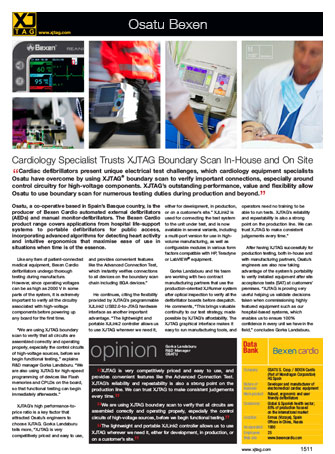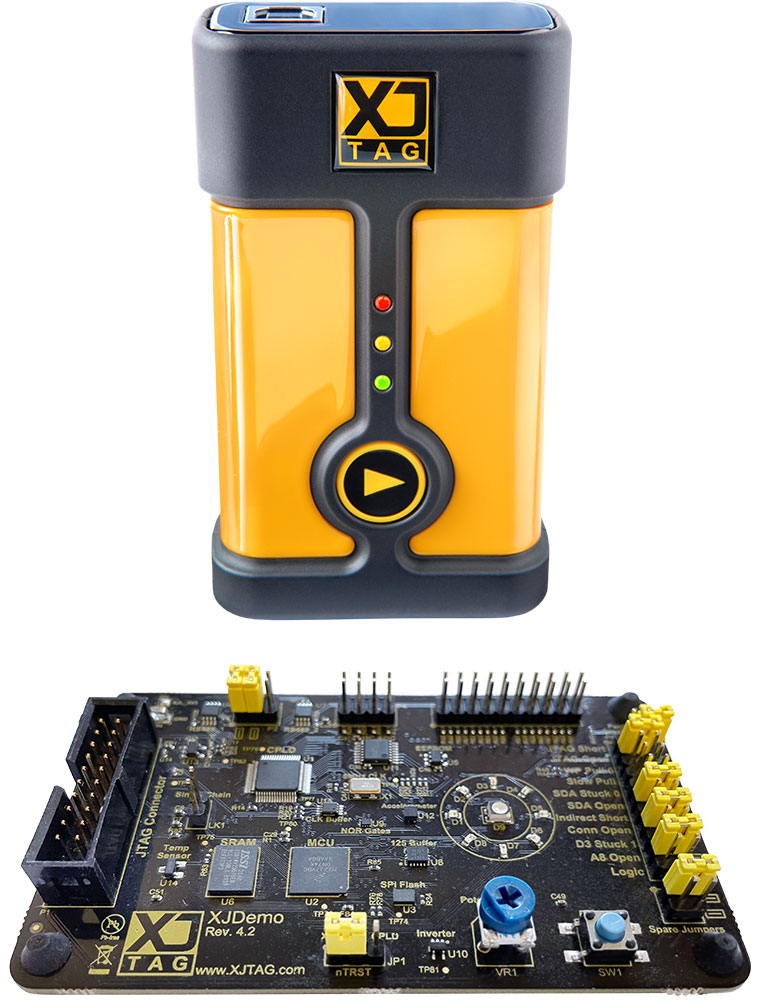
Cardiology Specialist Trusts XJTAG Boundary Scan In-House and On Site
Cardiac defibrillators present unique electrical test challenges, which cardiology equipment specialists Osatu have overcome by using XJTAG® boundary scan to verify important connections, especially around control circuitry for high-voltage components. XJTAG’s outstanding performance, value and flexibility allow Osatu to use boundary scan for numerous testing duties during production and beyond.
Osatu, a co-operative based in Spain’s Basque country, is the producer of Bexen Cardio automated external defibrillators (AEDs) and manual monitor-defibrillators. The Bexen Cardio product range covers applications from hospital life-support systems to portable defibrillators for public access, incorporating advanced algorithms for detecting heart activity and intuitive ergonomics that maximise ease of use in situations when time is of the essence.
Like any item of patient-connected medical equipment, Bexen Cardio defibrillators undergo thorough testing during manufacture. However, since operating voltages can be as high as 2000 V in some parts of the system, it is extremely important to verify all the circuitry associated with high-voltage components before powering up any board for the first time.
“We are using XJTAG boundary scan to verify that all circuits are assembled correctly and operating properly, especially the control circuits of high-voltage sources, before we begin functional testing,” explains R&D manager Gorka Landaburu. “We are also using XJTAG for high-speed programming of devices like Flash memories and CPLDs on the board, so that functional testing can begin immediately afterwards.”
XJTAG’s high performance-to-price ratio is a key factor that attracted Osatu’s engineers to choose XJTAG. Gorka Landaburu tells more, “XJTAG is very competitively priced and easy to use, and provides convenient features like the Advanced Connection Test, which instantly verifies connections to all devices on the boundary scan chain including BGA devices.”
He continues, citing the flexibility provided by XJTAG’s programmable XJLink2 USB2.0-to-JTAG hardware interface as another important advantage. “The lightweight and portable XJLink2 controller allows us to use XJTAG wherever we need it, either for development, in production, or on a customer’s site.” XJLink2 is used for connecting the test system to the unit under test, and is now available in several variants, including a multi-port version for use in high-volume manufacturing, as well as configurable modules in various form factors compatible with HP, Teradyne or LabVIEW® equipment.
Gorka Landaburu and his team are working with two contract manufacturing partners that use the production-oriented XJRunner system after optical inspection to verify all the defibrillator boards before despatch. He comments, “This brings valuable continuity to our test strategy, made possible by XJTAG’s affordability. The XJTAG graphical interface makes it easy to run manufacturing tools, and operators need no training to be able to run tests. XJTAG’s reliability and repeatability is also a strong point on the production line. We can trust XJTAG to make consistent judgements every time.”
After having XJTAG successfully for production testing, both in-house and with manufacturing partners, Osatu’s engineers are also now taking advantage of the system’s portability to verify installed equipment after site acceptance tests (SAT) at customers’ premises. “XJTAG is proving very useful helping us validate decisions taken when commissioning highly featured equipment such as our hospital-based systems, which enables us to ensure 100% confidence in every unit we have in the field,” concludes Gorka Landaburu.

XJTAG is very competitively priced and easy to use, and provides convenient features like the Advanced Connection Test. XJTAG’s reliability and repeatability is also a strong point on the production line. We can trust XJTAG to make consistent judgements every time.
We are using XJTAG boundary scan to verify that all circuits are assembled correctly and operating properly, especially the control circuits of high-voltage sources, before we begin functional testing.
The lightweight and portable XJLink2 controller allows us to use XJTAG wherever we need it, either for development, in production, or on a customer’s site.

Company: OSATU S. Coop. / BEXEN Cardio (Part of Mondragon Corporation); HQ Spain
Nature of business:
Developer and manufacturer of electromedical cardiac equipment
Main product: Robust, ergonomic and user friendly defibrillators
Customers: Global & Spanish health sector; 85% of production focused on the international market
Location: Ermua (Vizcaya), Spain
Offices in China, Russia
Incorporated: 1980
Employees: 25
Web site: www.bexencardio.com

Configure your products













